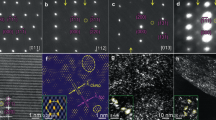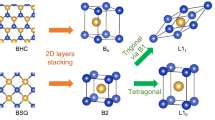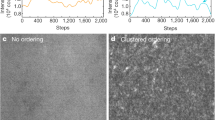Abstract
UNTIL quite recently, it was widely believed that order–disorder transformations in alloys were not phase transformations in the classical Gibbsian sense, but were homogeneous transformations in which the whole sample passed uniformly through a sequence of progressively more ordered states. A corollary of this view of the matter is that no two-phase fields incorporating both ordered and disordered phases can exist either transiently or in equilibrium. This view was first critically examined by Rhines and Newkirk1, with special reference to the Cu3Au and CoPt superlattices; they concluded that on the evidence then available, order–disorder transformations were classical; in particular, equilibrium two-phase regions exist in the Cu–Au and Co–Pt systems. Clear evidence, by X-ray diffraction, that the ordering process in stoichiometric CuAu involves classical nucleation and growth was advanced by O'Brien and Kuczynski2, and electron microscopic evidence of a two-phase structure in off-stoichiometric Cu3Au was presented by Marcinkowski and Zwell3. Doubts persisted about certain alloy systems based on body-centred cubic solvents, but recent investigations by Warlimont and others4–8 have established that in the Fe–Al and Fe–Si systems, broad equilibrium two-phase regions exist. They have established5,7, moreover, that such regions are of two types—a normal region, in which the dispersed ordered phase progressively coarsens on prolonged annealing, and an anomalous region in which interfacial and strain energy plays a crucial part and the particles of ordered phase remain permanently very finely dispersed. Strictly, only the first category can properly be described as a Gibbsian two-phase region.
This is a preview of subscription content, access via your institution
Access options
Subscribe to this journal
Receive 51 print issues and online access
$199.00 per year
only $3.90 per issue
Buy this article
- Purchase on Springer Link
- Instant access to full article PDF
Prices may be subject to local taxes which are calculated during checkout
Similar content being viewed by others
References
Rhines, F. N., and Newkirk, J. B., Trans. Amer. Soc. Metals, 45, 1029 (1953).
O'Brien, J. L., and Kuczynski, G. C., Acta Met., 7, 803 (1959).
Marcinkowski, M. J., and Zwell, L., Acta Met., 11, 373 (1963).
Lütjering, G., and Warlimont, H., Acta Met., 12, 1460 (1964).
Warlimont, H., Z. Metallkunde, 60, 195 (1969).
Leamy, H. J., Schwellinger, P., and Warlimont, H., Acta Met., 18, 31 (1970).
Warlimont, H., Z. Metallkunde, 59, 595 (1968).
Rimlinger, L., and Faivre, R., J. Nucl Mat., 28, 211 (1968).
Schneider, A., and Esch, U., Z. Elektrochem., 50, 290 (1944).
Assayag, P., and Dodé, M., CR Acad. Sci. (Paris), 239, 762 (1954).
Author information
Authors and Affiliations
Rights and permissions
About this article
Cite this article
IRANI, R., CAHN, R. A Classical Phase Transformation: Order—Disorder in CuPt. Nature 226, 1045–1046 (1970). https://doi.org/10.1038/2261045a0
Received:
Issue Date:
DOI: https://doi.org/10.1038/2261045a0
This article is cited by
-
Theory of atomic ordering in copper-platinum alloys
Soviet Physics Journal (1984)
-
The mechanism of crystallographic ordering in CuPt
Journal of Materials Science (1973)
-
Order hardening in equiatomic CuPt
Metallurgical Transactions (1973)
Comments
By submitting a comment you agree to abide by our Terms and Community Guidelines. If you find something abusive or that does not comply with our terms or guidelines please flag it as inappropriate.



